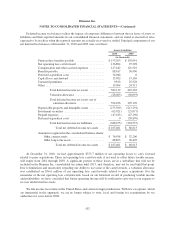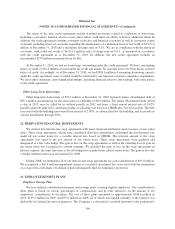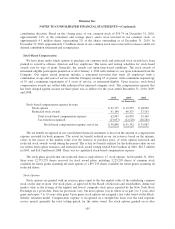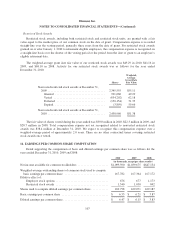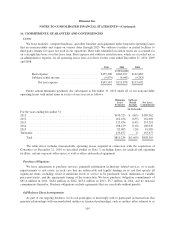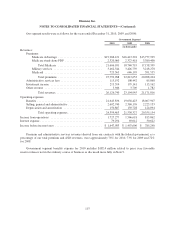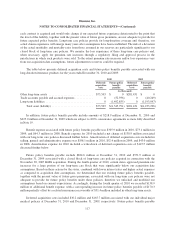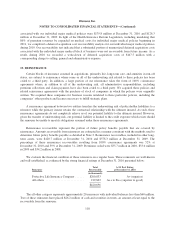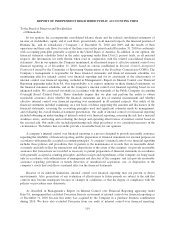Humana 2010 Annual Report Download - page 120
Download and view the complete annual report
Please find page 120 of the 2010 Humana annual report below. You can navigate through the pages in the report by either clicking on the pages listed below, or by using the keyword search tool below to find specific information within the annual report.Humana Inc.
NOTES TO CONSOLIDATED FINANCIAL STATEMENTS—(Continued)
structured finance or special purpose entities (SPEs), which would have been established for the purpose of
facilitating off-balance sheet arrangements or other contractually narrow or limited purposes. As of
December 31, 2010, we are not involved in any SPE transactions.
Guarantees and Indemnifications
Through indemnity agreements approved by the state regulatory authorities, certain of our regulated
subsidiaries generally are guaranteed by Humana Inc., our parent company, in the event of insolvency for
(1) member coverage for which premium payment has been made prior to insolvency; (2) benefits for members
then hospitalized until discharged; and (3) payment to providers for services rendered prior to insolvency. Our
parent also has guaranteed the obligations of our military services subsidiaries.
In the ordinary course of business, we enter into contractual arrangements under which we may agree to
indemnify a third party to such arrangement from any losses incurred relating to the services they perform on
behalf of us, or for losses arising from certain events as defined within the particular contract, which may
include, for example, litigation or claims relating to past performance. Such indemnification obligations may not
be subject to maximum loss clauses. Historically, payments made related to these indemnifications have been
immaterial.
Government Contracts
Our Medicare business, which accounted for approximately 65% of our total premiums and administrative
services only, or ASO, fees for the year ended December 31, 2010, primarily consisted of products covered under
the Medicare Advantage and Medicare Part D Prescription Drug Plan contracts with the federal government.
These contracts are renewed generally for a one-year term each December 31 unless CMS notifies us of its
decision not to renew by August 1 of the calendar year in which the contract would end, or we notify CMS of our
decision not to renew by the first Monday in June of the calendar year in which the contract would end. All
material contracts between Humana and CMS relating to our Medicare business have been renewed for 2011.
CMS uses a risk-adjustment model which apportions premiums paid to Medicare Advantage plans
according to health severity. The risk-adjustment model pays more for enrollees with predictably higher costs.
Under this model, rates paid to Medicare Advantage plans are based on actuarially determined bids, which
include a process whereby our prospective payments are based on a comparison of our beneficiaries’ risk scores,
derived from medical diagnoses, to those enrolled in the government’s original Medicare program. Under the
risk-adjustment methodology, all Medicare Advantage plans must collect and submit the necessary diagnosis
code information from hospital inpatient, hospital outpatient, and physician providers to CMS within prescribed
deadlines. The CMS risk-adjustment model uses this diagnosis data to calculate the risk adjusted premium
payment to Medicare Advantage plans. We generally rely on providers to code their claim submissions with
appropriate diagnoses, which we send to CMS as the basis for our payment received from CMS under the
actuarial risk-adjustment model. We also rely on providers to appropriately document all medical data, including
the diagnosis data submitted with claims.
CMS is continuing to perform audits of various companies’ selected Medicare Advantage contracts related
to this risk adjustment diagnosis data. These audits are referred to herein as Risk-Adjustment Data Validation
Audits, or RADV audits. RADV audits review medical record documentation in an attempt to validate provider
coding practices and the presence of risk adjustment conditions which influence the calculation of premium
payments to Medicare Advantage plans. To date, six Humana contracts have been selected by CMS for RADV
audits for the 2007 contract year, consisting of one “pilot” audit and five “targeted” audits for Humana plans.
110




